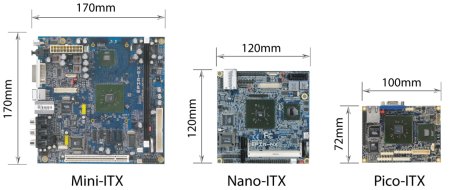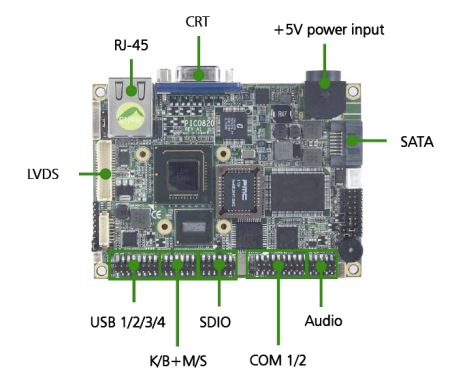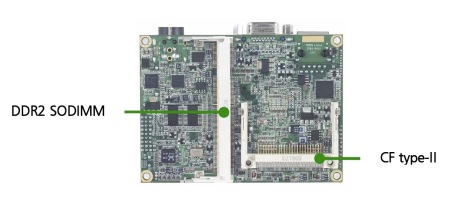Atom squeezes onto Pico-ITX board
Sep 2, 2008 — by LinuxDevices Staff — from the LinuxDevices Archive — 6 views Axiomtek has announced what it says is the world's first pico-ITX SBC (single board computer) packing Intel's Atom processor. The PICO820 offers 1.1GHz or 1.6GHz Z5xx CPUs, gigabit Ethernet, a SATA port, a VGA port, and headers for four serial ports, the company says.
Axiomtek has announced what it says is the world's first pico-ITX SBC (single board computer) packing Intel's Atom processor. The PICO820 offers 1.1GHz or 1.6GHz Z5xx CPUs, gigabit Ethernet, a SATA port, a VGA port, and headers for four serial ports, the company says.
(Click here for a larger view of Axiomtek's PICO820)
The PICO820 uses Via Technologies' tiny 3.9 x 2.8 inch (10 x 7.2cm) pico-ITX format, which first broke cover at the beginning of January 2007. The form factor has approximately half the surface area of Via's already small 4.7 x 4.7-inch (12 x 12cm) Nano-ITX standard, and is considerably smaller than the original 6.7-inch square (17 x 17cm) mini-ITX standard.

Via's incredible shrinking motherboard
(Click for details)
Pico-ITX boards seen to date have, not surprisingly, sported Via processors. However, Via recently transferred ownership of the spec to the Small Form Factor SIG (special interest group), which maintains it has an open, vendor-neutral standard supporting the SUMIT stackable board interface. The PICO820 does not appear to use a SUMIT connector, however, offering expansion via pin headers, instead.
The Atom-powered PICO820 requires only 5VDC input power and, Axiomtek claims, is capable of fanless operation. It uses Intel's 1.1GHz Z510 or 1.6GHz Z530, which measure just 14 x 13mm and have two-Watt TDPs. As usual, the processors are paired here with the chipmaker's comparatively huge SCH US15W companion chip.
Axiomtek touts the SCH US15W's integrated Intel Graphics Media Accelerator 500 capabilities, said to offer “advanced graphics and 3D performance.” The Atom Z5xx series also supports hyper-threading technology and SIMD (single instruction, multiple data) extensions, which improves the PICO820's performance on multimedia and gaming applications, Axiomtek says.

Axiomtek's PICO820 has real-world RJ45, VGA, and SATA connectors
As the above photo shows, the PICO820 squeezes in a RJ45 conector for gigabit Ethernet, a 5VDC power input, and an SATA port. Additional interfaces, supplied via pin headers, include four USB ports, SDIO, PS/2 style keyboard/mouse, audio I/O, and two serial ports.
The PICO820 includes both an actual VGA connector, for CRT displays, and a pin header for LVDS-interfaced LCDs. The former supports resolutions up to 2048 x 1536 pixels, according to the company.

The rear of the SBC has SO-DIMM and CompactFlash connectors
On the reverse of the board (above), the PICO820 has a single 200-pin SO-DIMM socket, supporting up to 1GB of DDR2 RAM. It also has a Type II CompactFlash slot, says Axiomtek.
Features and specifications listed for the PICO820 by Axiomtek include:
- Processor — Intel Atom Z510 (1.1GHz) or Z530 (1.6GHz)
- Memory — Up to 1GB of DDR2 RAM, via single SO-DIMM slot
- Storage — SATA port, plus CompactFlash slot
- Display — Supports CRT displays via VGA port, and LCD displays via LVDS pin header
- Networking — 1 x gigabit Ethernet
- Other I/O:
- 1 x VGA port
- 1 x LVDS (pin header)
- 4 x USB (pin headers)
- PS/2 keyboard/mouse (pin headers)
- 5VDC power input connector
- 1 x SDIO (pin header)
- 1 x SATA
- audio line out/line in/mic in (pin header)
- 1 x VGA port
- Operating temperature — 0 to 60 deg. C
- Dimensions — 3.9 x 2.8 inches (100mm x 72mm)
Axiomtek did not release pricing, but said the RoHS-compliant PICO820 will be available during the fourth quarter. Operating system support was also not discussed; however, with its standard chipsets and cited Phoenix-Award BIOS, the PICO820 is likely to be compatible with embedded operating systems such as Linux, Windows XP Embedded, and Windows CE.
Earlier Pico-ITX boards include:
- The Epia PX10000G, with a 1GHz C7 CPU
- The Epia PX5000G, with a 500MHz Eden ULV
- The Epia P700, with a 1GHz C7 or 500MHz Eden ULV, and optional “wings” offering an expanded array of “real world” connectors.
This article was originally published on LinuxDevices.com and has been donated to the open source community by QuinStreet Inc. Please visit LinuxToday.com for up-to-date news and articles about Linux and open source.